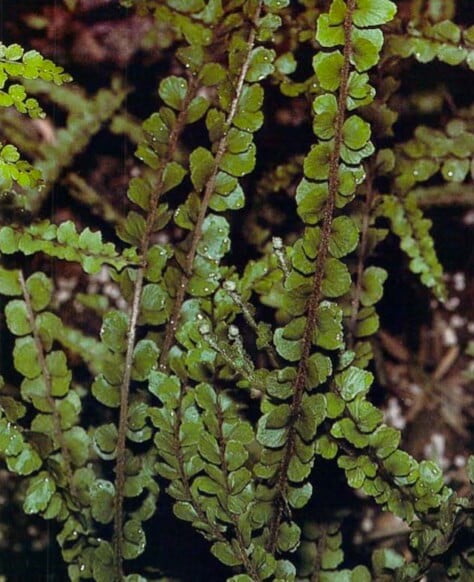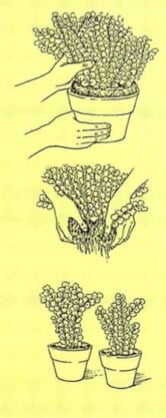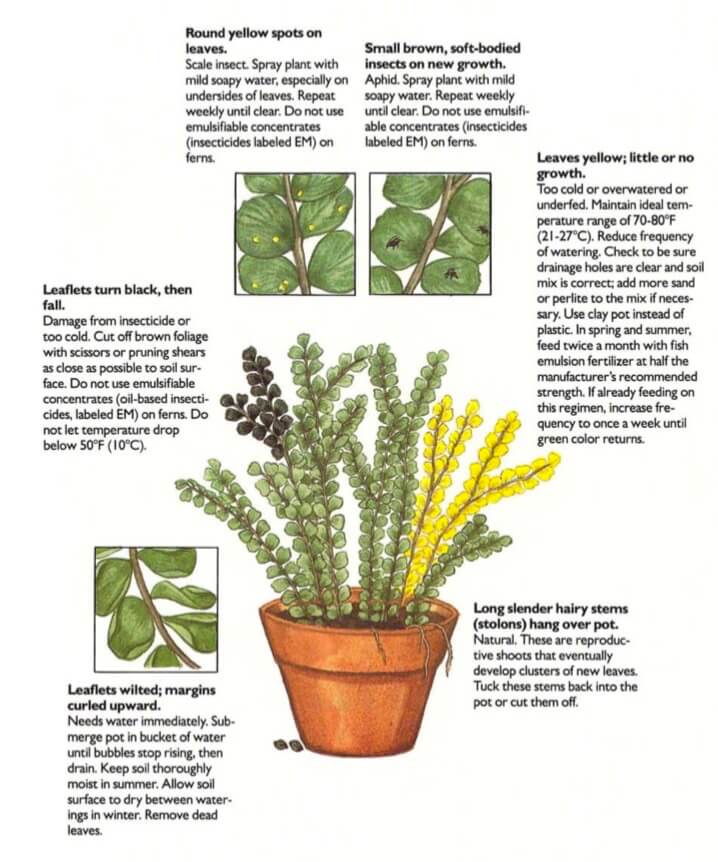[Ebook Việt Hoá] The Instant Guide to Healthy Houseplants (Hướng dẫn tức thời để chăm cây trong nhà khoẻ mạnh), Chi Nephrolepis
[Ebook Việt Hoá] The Instant Guide to Healthy Houseplants: Nephrolepis cordifolia ‘Duffii’ (Duff’s sword fern)
- Nguồn: [Ebook Việt Hoá] The Instant Guide to Healthy Houseplants (Hướng dẫn tức thời để chăm cây trong nhà khoẻ mạnh)
- Biên tập: Dũng Cá Xinh
- Biên dịch: Team Codai.net
English
Duff’s sword fern comes from a line of attractive natural variants of the common sword fern of the tropics. The erect leaves of this plant are quite narrow-less than 1 inch (1-2 cm) in width-compared with their length-2 feet (60 cm). The tips of the leaves are divided or forked, making the plant look as if it had a crest at the top. Individual leaflets are rounded with dark green veins and wavy, toothed margins. Like other sword ferns, Duff’s is nearly indestructible, making it an excellent houseplant year-round.

Light
Tolerates very low levels of light, such as found in north or east-facing windows, but also thrives in the bright light of a south or west-facing window if it is shaded with a sheer curtain.
Temperature
Keep at a minimum temperature of 50°F (10°C) in winter. Ideal temperature range year-round is 70-80°F (21-27°C).
Water
Water 3-4 times a week in summer, less often in cooler temperatures. Keep soil moist, allowing soil surface to dry between waterings in winter.
Humidity
Tolerates moderate to low humidity. Mist 2-3 times a week.
Soil
Use a well-drained soil mix such as equal parts potting soil, builder’s sand, peat or leaf mold and perlite.
Feeding
In spring and summer, feed twice a month with a solution of fish emulsion at half the manufacturer’s recommended strength. Do not fertilize newly repotted plants for 1 month.
Repotting
Repot when fern outgrows pot. (New growth will be stunted.) Add 2 tablespoons each of bone meal and composted cow manure per gallon of soil mix.
Cleaning
Use tepid, mild soapy water to wipe leaves. Use no leafshine.
Propagation
Divide fern when it completely fills container. Remove fern from container. Gently pull apart clusters of leaves. Remove and discard old dry fronds. Repot clusters, several to a pot. (Clay pots are best.)

What Goes Wrong

- Round yellow spots on leaves: Scale insect. Spray plant with mild soapy water, especially on undersides of leaves. Repeat weekly until clear. Do not use emulsifiable concentrates (insecticides labeled EM) on ferns.
- Leaflets tum black, then fall: Damage from insecticide or too cold. Cut off brown foliage with scissors or pruning shears as close as possible to soil surface. Do not use emulsifiable concentrates (oil-based insecticides, labeled EM) on ferns. Do not let temperature drop below 50°F ( 10°C).
- Small brown, soft-bodied insects on new growth: Aphid. Spray plant with mild soapy water. Repeat weekly until clear. Do not use emulsifiable concentrates (insecticides labeled EM) on ferns.
- Leaflets wilted; margins curled upward: Needs water immediately. Submerge pot in bucket of water until bubbles stop rising, then drain. Keep soil thoroughly moist in summer. Allow soil surface to dry between waterings in winter. Remove dead leaves.
- Long slender hairy stems (stolons) hang over pot: Natural. These are reproductive shoots that eventually develop clusters of new leaves. Tuck these stems back into the pot or cut them off.
- Leaves yellow; little or no growth: Too cold or overwatered or underfed. Maintain ideal temperature range of 70-80°F (21-27°C). Reduce frequency of watering. Check to be sure drainage holes are clear and soil mix is correct; add more sand or perlite to the mix if necessary. Use clay pot instead of plastic. In spring and summer, feed twice a month with fish emulsion fertilizer at half the manufacturer’s recommended strength. If already feeding on this regimen, increase frequency to once a week until green color returns.
Tiếng Việt
Dương xỉ kiếm Duffs xuất phát từ một dòng biến thể tự nhiên của dương xỉ kiếm thông thường ở vùng nhiệt đới. Những chiếc lá mọc thẳng của loài cây này khá hẹp – chiều rộng chưa đến 1 inch (1-2 cm) so với chiều dài 60 cm của chúng. Các đầu của lá được chia hoặc chẻ làm cho cây trông như thể nó có một cái mào ở trên cùng. Những lá non riêng lẻ có hình tròn với các gân xanh đậm và mép có răng, lượn sóng. Giống như các loại dương xỉ kiếm khác, Duff’s khó bị hư hại, khiến nó trở thành cây trồng trong nhà tuyệt vời quanh năm.

Ánh sáng
Chịu được ánh sáng rất thấp, chẳng hạn như ở các cửa sổ quay mặt về hướng Bắc hoặc Đông, nhưng cũng phát triển tốt khi có ánh sáng chói của cửa sổ hướng Nam hoặc hướng Tây nếu nó được che bằng rèm dày.
Nhiệt độ
Giữ ở nhiệt độ tối thiểu là 50 độ F (10 độ C) vào mùa đông. Phạm vi nhiệt độ lý tưởng quanh năm là 70-80 độ F (21-27 độ C).
Nước
Tưới 3-4 lần một tuần vào mùa hè, ít hơn ở nhiệt độ mát hơn. Giữ ẩm cho đất, theo dõi bề mặt đất khô giữa các lần tưới vào mùa đông.
Độ ẩm
Chịu được độ ẩm trung bình đến thấp. Phun sương 2-3 lần một tuần.
Đất
Sử dụng hỗn hợp đất thoát nước tốt như đất bầu, cát xây dựng, than bùn hoặc đất xốp và đá trân châu.
Bón phân
Vào mùa xuân và mùa hè, bón hai lần một tháng bằng đạm cá với nồng độ một nửa theo khuyến cáo của nhà sản xuất. Không bón cho cây mới thay chậu trong vòng 1 tháng.
Thay chậu
Thay chậu khi dương xỉ mọc cao trong chậu. (Chồi mới sẽ còi cọc.) Thêm 2 muỗng canh bột xương và phân bò ủ hoai vào mỗi gallon hỗn hợp đất.
Làm sạch
Dùng xà phòng loãng để lau lá. Không sử dụng xịt bóng lá.
Nhân giống
Chia dương xỉ khi nó mọc đầy thùng chứa. Loại bỏ dương xỉ khỏi thùng chứa. Nhẹ nhàng kéo các cụm lá rời ra. Loại bỏ các lá già khô. Thay chậu và cho vài cụm vào một chậu. (Chậu đất sét là tốt nhất.)

Những vấn đề có thể xảy ra

- Các đốm vàng tròn trên lá: Sâu bọ. Phun cây bằng xà phòng loãng, đặc biệt là mặt dưới của lá. Lặp lại hàng tuần cho đến khi sạch. Không sử dụng chất nhũ hóa cô đặc (thuốc diệt côn trùng có nhãn EM) trên dương xỉ.
- Lá non chuyển màu đen, sau đó rụng: Thiệt hại do thuốc trừ sâu hoặc quá lạnh. Sử dụng kéo hoặc kéo cắt tỉa để cắt bỏ những tán lá nâu càng gần bề mặt đất càng tốt. Không sử dụng chất nhũ hóa cô đặc (thuốc trừ sâu dạng dầu, có nhãn EM) trên dương xỉ. Không để nhiệt độ giảm xuống dưới 50 độ F (10 độ C).
- Côn trùng thân mềm, nhỏ màu nâu đang phát triển: Rệp. Phun cây bằng xà phòng loãng. Lặp lại hàng tuần cho đến khi sạch. Không sử dụng chất nhũ hóa cô đặc (thuốc diệt côn trùng có nhãn EM) trên dương xỉ.
- Lá non bị héo; mép cong lên: Cần tưới nước ngay lập tức. Nhúng chậu vào xô nước cho đến khi hết bọt, sau đó để ráo. Giữ ẩm kỹ cho đất vào mùa hè. Để bề mặt đất khô giữa các lần tưới vào mùa đông. Loại bỏ lá chết.
- Thân dài có lông tơ rủ xuống chậu: Tự nhiên. Đây là những chồi sinh sản cuối cùng phát triển thành các cụm lá mới. Đặt những thân cây này vào lại chậu hoặc cắt bỏ chúng.
- Lá màu vàng; tăng trưởng ít hoặc không tăng trưởng: Quá lạnh hoặc thừa hoặc thiếu phân bón. Duy trì phạm vi nhiệt độ lý tưởng 70-80 độ F (21-27 độ C). Giảm tần suất tưới nước. Kiểm tra để chắc chắn rằng các lỗ thoát nước đã thông thoáng và hỗn hợp đất phù hợp; thêm cát hoặc đá trân châu vào hỗn hợp nếu cần. Sử dụng chậu đất thay vì nhựa. Vào mùa xuân và mùa hè, bón hai lần một tháng bằng phân bón đạm cá với liều lượng một nửa so với khuyến cáo của nhà sản xuất. Nếu đã bón phân theo chế độ này, hãy tăng tần suất lên một lần một tuần cho đến khi lá xanh trở lại.
![[Ebook Việt Hoá] The Instant Guide to Healthy Houseplants: Nephrolepis cordifolia ‘Duffii’ (Duff’s sword fern) [Ebook Việt Hoá] The Instant Guide to Healthy Houseplants: Nephrolepis cordifolia ‘Duffii’ (Duff’s sword fern)](https://vn1.vdrive.vn/codai.net/2020/02/ebook-huong-dan-tuc-thoi-cham-cay-trong-nha-khoe-manh-37-nephrolepis-cordifolia-duffii.jpg)


